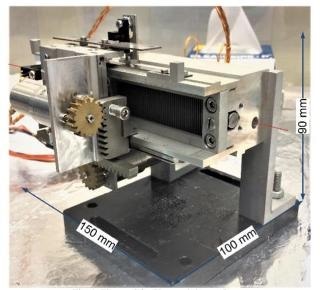Nov 9 2018
Physicists at BFU proposed a new model of a variable focus lens known as a mini transfocator. It could be used in microscopic research that requires compact and mobile optical platforms. The development was aided by the Ministry of Education and Science with a grant (No. 14. Y26.31.0002). The results were reported in the Microscopy and Microanalysis journal.
 Mini transfocator for X-rays microscopy. (Credit - A. Narikovich, P. Ershov, I. Lyatun, I. Panormov, A. Sinitsyn, and A. Snigirev)
Mini transfocator for X-rays microscopy. (Credit - A. Narikovich, P. Ershov, I. Lyatun, I. Panormov, A. Sinitsyn, and A. Snigirev)
Lens optical systems and X-ray lenses are presently used in microscopy, for forming high-resolution X-ray images, and for focusing X-rays to submicron scale. In order to focus X-rays, one may alter the combination or the number of lenses. To achieve that, researchers use variable focus lenses or transfocators. These are systems with modifiable lenses that can be added or removed to an X-ray beam to control the focus distance. The transfocator’s configuration is easily adjustable; hence it is used for preliminary focusing along with other focusing elements, and also as an autonomous focusing device in a beam.
These are the methods we suggested and successfully promoted at the ESRF synchrotron in France and at the German PETRA-III synchrotron at DESY. But for them to work, we need light and mobile transfocators. They should be easy to install and to adjust in the direction of a scattered or diffracted beam.
Anatoly Snigirev, Supervisor of “Coherent Optics” Specialization, and Head of X-ray Optics Laboratory, Immanuel Kant Baltic Federal University.
Traditional transfocators are relatively heavy and cannot be employed for X-ray visualization on site or for introscopy (non-invasive examination of the structure and internal processes of biological objects). Furthermore, gaps can occur between their cartridges. In such cases it becomes tough to gradually change the focus distance as the lenses that are situated close to each other and those positioned along the beam will have different focus positioning. Mobile mini transfocators help to explore the internal structure and peculiarities of biological samples and track variations in them. They are also used in the new area of studies called hard X-rays microscopy. The lens is used as an objective and displays the details of the sample with submicron or even nanometer resolution. In addition to nondestructive studies of biological objects, this is particularly pertinent for studies conducted in extreme conditions (under high temperature or pressure).
In the new transfocator model, the lenses are attached separately on stacks and are positioned close to each other. So, one lens can be easily added or removed, and the focus distance would change progressively. This type of design is more compact and mobile. The length of the transfocator is 150 mm, the height - 90 mm, and the width - 100 mm, while its weight is less than 2 kg. Depending on their function, traditional transfocators may measure 0.5 to 1.5 m in length and weigh from 20 to 100 kg. All materials and components are vacuum compatible and are produced using high-precision equipment. An electric engine is used to move 50 independent lenses that stand in the way of the beam.
The participants of the experimental studies also represented the European Molecular and Biological Laboratory in Hamburg (Germany) and the Research Accelerator Complex ESRF (European Synchrotron Radiation Facility) in Grenoble (France).